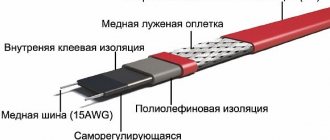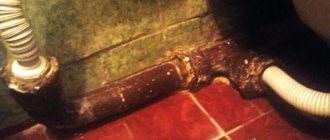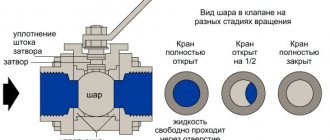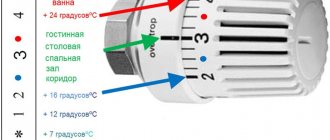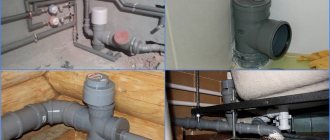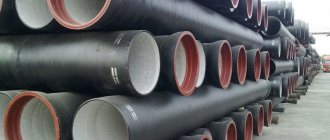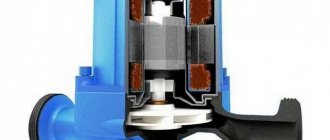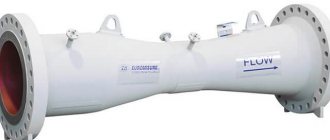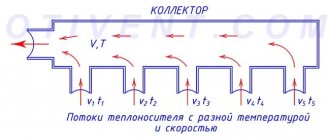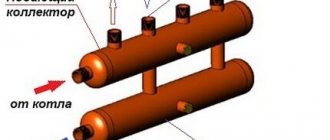A sewage pumping station is installed to ensure the natural outflow of waste and its recycling. The choice in favor of a sewer pumping station is also made in cases where the gravity system does not give the desired result, and it is necessary to ensure the required angle of inclination of the sewer pipes. The type of pumping station depends on the facility where it is installed.
For private country houses, both mini-stations and multifunctional complex systems can be used. Each type has its own operating characteristics and technical characteristics that must be taken into account when selecting a system and equipment.
Purpose of the cleaning complex
Sewage stations are used as the main mechanism for removing wastewater. Under the influence of pump pressure, the waste liquid is directed to a higher level, as a result of which it moves by gravity towards the cleaning mechanism.
In cases where sewage waste flows on its own, pumping equipment may not be required. This is rather an exception and is relevant only for the plateau. If the terrain is uneven or hilly, you cannot do without the use of special technical equipment. Therefore, the use of technical devices simplifies the cleaning process.
The use of sewage wastewater equipment has a beneficial effect on environmental indicators in the area where they are installed at treatment pumping stations. Thanks to this, local residents are less likely to get sick or experience any discomfort.
To avoid contact of operating personnel with drained liquids, wastewater is transported in a special isolated system.
Types of sewage pumps and their features
Pumping equipment is the main part of the pumping station. It pumps domestic wastewater, industrial waste, sludge, and storm water. There are the following types of sewage pumps:
- submersible;
- console;
- self-priming.
A submersible sewage pump is a pressure device that is constantly submerged. Materials for the manufacture of such a pump are selected that are resistant to aggressive environments.
Most often, submersible sewage pumps are used in sewage pumping stations. They are effective and easy to use
The device is convenient and takes up relatively little space, since it is constantly submerged; there is no need to prepare a separate site for it and additional pipework. Advantages of this type of pumps:
- reliability;
- ease of operation;
- rare maintenance;
- ability to work effectively at low temperatures;
- cooling by surrounding and flowing liquid;
- versatility: pumps can also be used for dry installation.
A cantilever dry-installation sewage pump is a device most often used in large industrial pumping stations. Such pumps are not installed in modular stations. When installing them, it is necessary to prepare a separate foundation and install the pipes correctly.
Dry installation cantilever sewage pumps require a separate foundation and are used in large industrial-level pumping stations
It is better to entrust the commissioning of such a pump to specialists. Cantilever pumps stand open and are easily accessible, which greatly simplifies repair work. Advantages of console pumping devices:
- reliability;
- convenient access to the impeller and motor;
- ease of maintenance;
- the ability to change performance due to the correct selection of the electric motor and other design elements.
A self-priming dry installation sewage pump is a unit used in municipal and industrial pumping stations for pumping heavily polluted wastewater.
Self-priming pumps are not subject to clogging and are effective at low temperatures. The only negative is the high price
These devices are easy to maintain due to the design of the electric motor with flange mounting, and do not become clogged due to the spacious passage in the nozzle and impeller. Advantages of the device:
- easy to maintain due to the retractable design;
- little susceptible to clogging;
- works at negative temperatures when installing a special heating element;
- pumps sewage with solid elements and sediment;
- Maximum tightness thanks to double mechanical seal;
It should also be noted that, if necessary, such a pump can be easily dismantled.
Main types of pumping station
The sizes of household pump stations can vary from very small to huge. Since such systems can be located exactly behind the drain tank, discharging liquids directly in the required direction (for example, household pumping stations Grundfos Sololift2), or take the form of a tank, with a volume of several tens of cubic meters, horizontally dug into the ground.
In addition to size, CNSs differ in a number of other parameters:
- Installation type: horizontal, vertical, with automatic pumps.
- Type of location: above ground, buried, partially buried.
- Type of system control: remote, automatic, manual.
Types of control
- Remote. The monitoring data is sent to a remote control panel. The dispatcher himself makes the decision that needs to be taken.
- Automatic. The cleaning system is controlled in a constant automated mode, using special sensors located on the system body or close to it.
- Manual. Control over the equipment and the system as a whole is carried out by maintenance personnel. They also control the filling of the tank.
Type of sewer
- Industrial. This type of cleaning equipment is made from a special durable material that can withstand chemical or thermal exposure.
- Household. Installation of a sewage pumping station designed to operate under standard conditions.
- Stormwater. Such systems are equipped with additional cleaning equipment.
- Sedimentary. Such a station is mainly used in industrial areas, additionally processing sediment.
Equipment selection rules
Before making a choice of CNS, you need to consider the following factors:
- total volumes of pumped liquid during normal operation of the station;
- local landscape – depth of the main sewer lines,
- height difference between connected equipment;
- type of waste – degree of contamination, temperature;
- control method and feasibility of work automation.
For a small family with low water consumption, a miniature station is suitable. Such models are inexpensive and small in size. Pumping waste to higher ground will require more effort. Therefore, in such landscape conditions, a powerful pump is necessary, even if the amount of liquid is small.
Some of the equipment is equipped with special knives that crush large fractions in wastewater. If there is a need for such an option, then you can select the level of grinding of solid particles. The price of the equipment depends on the power, degree of cleaning, and type of control. Manual models are cheaper than automatic ones. On the other hand, they require regular monitoring of performance.
Based on a detailed study of operating conditions, the optimal station model is selected. Before choosing a station for pumping wastewater, you should check the maximum liquid temperature. Some installations operate in a limited temperature range. This is due to the material from which the pipes and container are made.
Operating principle of the CNS
Scheme of operation of the pumping station The main principle of operation of the sewerage pumping system is the lifting of wastewater, followed by cleaning of the structure. In addition, pumping stations are used in case of emergency.
For the most part, pumping stations operate in automatic mode, controlled by four sensors installed directly on or near it.
- The mechanism is responsible for controlling small volumes of wastewater. This allows you to avoid starting the pump.
- The sensor is directly responsible for starting the pump. Only after this, the sewer system begins pumping waste into the reservoir.
- The sensor ensures that the backup pump starts. Its activation means an increased volume of wastewater.
- The last sensor turns on when an emergency occurs. This may occur due to a breakdown of one of the pumps, or when the device is not able to cope with the volume of liquid. In this case, the help of a special organization will be required.
Automatic shutdown of the sewage pumping station system occurs after the wastewater level drops below the first sensor. After this, the CNS will operate in a stable mode.
Why should you turn to professionals?
The specialist knows how to determine the regulating and receiving volume of the reservoir of the pumping station body, and how to justify the choice. The specialist will give detailed instructions for operation and maintenance in the conditions where the system is installed. That is, a professional knows how to make the CNS work efficiently and effectively.
What does Mayak LLC offer? Equipment for installation and connection of sewerage systems. We are a manufacturer, which allows us to offer high-quality systems and equipment. Production control at all stages is a guarantee of quality.
Our offer includes standard pumping stations, the functionality and performance of which are much higher than standard offerings on the market, as well as equipment for individual projects. Distinctive characteristics of our equipment:
- strength and resistance to soil pressure;
- chemical resistance;
- light weight, which is convenient for installation and transportation;
- durability;
- ease of maintenance.
The system body is made of fiberglass or polypropylene. The product has a 5-year warranty.
Our advantages:
- compliance of products with GOSTs and safety and environmental standards;
- providing more affordable prices due to in-house production of equipment;
- comprehensive solution of problems due to a variety of products (including for water supply) and terms of cooperation;
- qualifications and professional growth of the company and personnel;
- delivery of equipment throughout Moscow, the region and regions of the country.
The cost of the pumping station is calculated individually. To find out what offers we have and choose the right one, contact us in a convenient way.
KNS service
Maintenance of a sewage pumping station is a series of specialized activities that help maintain the system in good condition.
In order to ensure the operability of all station mechanisms, constant monitoring of routine maintenance servicing the control and warning system, pipelines, and sensors is necessary.
Compliance with all rules for using equipment will reduce the risk to a minimum level, which in turn will have a beneficial effect on operation.
Advantages of pumping stations
One of the advantages of modern CNS is that they can be easily installed both on new systems and on existing ones. In addition, they have many more advantages, which include the following:
- compact;
- environmentally friendly;
- economical in terms of electricity;
- almost silent;
- minimal vibration;
- simple installation and dismantling;
- do not take up much space;
- sealed;
- durable.
SPS design
The design of the mechanism must be evaluated in several basic options:
Cleaning system for a private home
A complex of individual structures that are selected individually, taking into account the engineer’s amendments.
Due to the non-standard size, the equipment may be buried under soil. The equipment looks like a sealed container with pumps inside. Plastic and fiberglass are used to produce the tank. The choice of this type of material increases the service life of the sewage pumping station by an average of fifty years.
Individual parts of the system:
- Plastic tank. Sometimes, such a tank is made on a metal or concrete base. But usually, plastic is the main material commonly used. Due to the fact that it has a long service life and allows, if necessary, to replace the tank in the shortest possible time.
- Pump for feces. If the station operates daily, then such systems provide an additional pump.
- Water supply (supply and discharge)
This is necessary to combine a common sewer system with pumps and a collector. The presence of a special valve prevents liquid from flowing in the opposite direction.
Automatic system with four sensors (floats)
Such a system is not expensive, so experts recommend purchasing it in any case. Since each of them is capable of starting the pump in the event of a critical rise in wastewater.
The principle of operation of such a station is slightly different from the operation of a mini-station in that the tank itself is dug in or buried in the ground and connected to a drain pipe. When the wastewater rises to a certain set level, the sensor closes the network and activates the main pump.
Compact mini-stations (sololift)
Single equipment that is selected individually, taking into account a number of characteristics.
Such a mini-station is installed directly in the bathroom or in the basement of the house.
When the liquid enters, the automatic system is activated (the engine is turned on). After which, the liquid is pumped from the reservoir into the pipe, being crushed along the way by a cutting mechanism. This prevents possible blockages.
Additional devices:
- Ladder to get down to the tank
- Special cabinet for system control
- Additional filters
- Flow sensors
- Garbage containers
Where are they used?
Centrifugal pump: scope of application
Sewage pumps are used not only for home but also for industrial use. The more expensive the pump, the more powerful and better quality it is.
High-performance pumps capable of pumping technical liquids with large fractions
Chinese plumbing pumps have plastic parts in the body that quickly fail.
The scope of application of this type of pump is very wide:
- For draining wastewater from a washing machine. This option is acceptable if you connect the pump and corrugated pipe directly to each other. Suitable for both kitchen and bathroom;
- Dishwasher safe. It is necessary to purchase a model that can work with fat-based waste;
- For the removal of sewer liquids in studio apartments, etc.
A pump for a sink should be purchased with low power, designed for small volumes of water, and a sanitary pump for the kitchen, on the contrary, should operate at high speeds.
The sewage pump for the apartment is connected directly to the outlet for the kitchen, and in some cases it can be soldered to the filtration system.
Kitchen pump for installation directly under the sink or in a kitchen cabinet
Calculation of pumping station
The calculation of a sewage pumping station begins with determining the main parameters of the equipment, productivity, and wastewater level (the inflow within one hour is taken into account).
Equipment parameters:
- Tank volume
- Tank depth
- Number of working pumps
- Number of backup pumps
- Pipe diameter
- Power supply
Performance parameters:
- Required number of pump starts
- Type of waste system
- Differences in head heights
- Using a special control mechanism
Based on the given parameters, the prepared information must be provided to specialists, thanks to whom it will be possible to select individual components for the equipment. If you do otherwise, the incorrectly selected components for the sewer pumping system will malfunction, which can lead to an emergency.
Installation - practical advice
The installation and connection of a sewer pump in an apartment for the kitchen can be entrusted to a specialist. But, having basic plumbing skills and having studied some of the subtleties, you can do the installation yourself.
- You can install the pressure pump in any convenient place (cabinets under the sink, niches, open areas). The water in the area from the device to the pump moves by gravity, so the outlet pipes must be located vertically or at an angle.
- Several pumps cannot be combined into a common network. Each of them must have its own outlet to the common sewer.
- On long sections of the outlet pipe located below the pump level, it is necessary to install an air valve to air the pipes.
- The power supply to the pump is connected via a separate line. If the sewage pump model has a cord with a plug, the socket to it is also laid from the RCD device.
Attention! Only high-strength polypropylene pipes can be used as pump outlet pipes. The use of corrugated or cast iron pipes is unacceptable.
Typical installation errors
Damage to tank walls, connections or associated pipes can occur if the tank is not installed correctly, tilted or backfilled incorrectly. Such problems threaten manual excavation of the container and considerable financial costs.
Therefore, you should sort out typical mistakes in advance so as not to repeat them when installing your own pump station.
- Incorrect soil filling. Possible mistakes: filling with frozen soil or large stones, lack of layer-by-layer compaction. The consequence may be subsidence of the earth with damage or displacement of the internal pipeline.
- Different type of backfill from different sides. If you poured sand into the pit on one side and earth on the other, then over time the container may become distorted, causing damage to the external pipes or the tank itself.
- Incorrect assessment of the amount of groundwater, which causes severe subsidence of the entire sewage pumping station with rupture of pipes and damage to the reservoir.
- Using wedges to level foundation slabs. The consequence may be a gradual displacement of the tank to the side with rupture of pipes.
Only people with geodetic education and experience in installing similar structures can evaluate the correct installation of the SPS. Therefore, you should not trust the installation of this expensive equipment to non-specialized organizations.
Small pumps for plumbing
A sewer pump designed for a washbasin or toilet is a small-sized device that is mounted next to plumbing fixtures. From them, the wastewater first flows into a small tank, and then it is pumped out of it into the building’s sewer system.
Such pumping equipment is expensive, but its installation allows you to locate the plumbing in a place convenient for the user. After filling the sewer tank, the pump will pump sewage into the riser, even if the outlet into it is inclined upward.
Structurally, such systems are designed to self-clean the storage tank, so they require almost no maintenance. To prevent the appearance of unpleasant odors, there is a carbon filter inside the tank. To connect such units, no special skills are required. Caring for them involves cleaning the drive.
When is forced removal of wastewater necessary?
Typically, removal of human waste from a sewer system occurs naturally under the influence of gravity. Unfortunately, it is not always possible to practically organize this process at a sufficiently effective level. Here are a few reasons why a homeowner should consider (or consider) installing a forced drainage system:
- the situation is such that the level of the main sewer drain is located higher than the waste discharge point;
- the waste discharge point is located too far from the main sewer drain;
- wastewater moves through sewer pipes too slowly;
- sewerage often becomes clogged due to errors made during its installation.
Some of these problems may be caused by flaws in the design of the sewer system or its improper redevelopment. But it also happens that, due to the configuration of the building or the topography of the site, the sewer pump station becomes the only choice for the normal operation of the sewer system. Sometimes installing a sewerage system is simply cheaper than completely redoing the sewer system, eliminating previously made mistakes.
Working environment temperature
When installing a household sewerage system with a pump, equipment of two categories is used:
- For cold waste liquids whose temperature does not exceed 45 degrees.
- For hot wastewater with an operating temperature of up to 90 degrees.
If you plan to send only cold water to the sewer, then it is better to purchase the first pump option, since it is cheaper. Most often, such units are installed in country cottages. A liquid with a temperature of more than 100 degrees can enter the sewer system of a private house only in the event of an emergency discharge from the heating system.
General information
To service private homes, it is advisable to use household pumping stations, which are characterized by their compact dimensions and affordable cost. When choosing a specific modification of a water pumping station for a home, the expected volume of wastewater, the degree of its contamination, as well as the type of contaminants that are present in such waters are taken into account. In addition, it is necessary to take into account the topography of the area where the station will be installed, as well as the depth of the sewer pipes.
Household mini pump station
